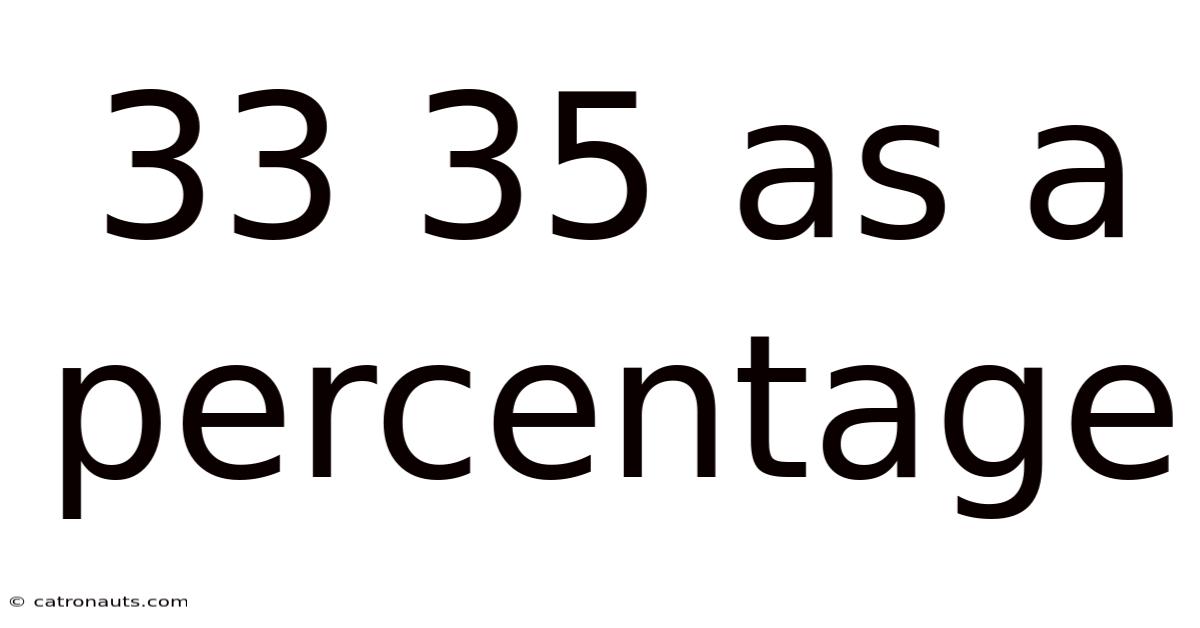33 35 As A Percentage
catronauts
Sep 11, 2025 · 4 min read

Table of Contents
Understanding 33/35 as a Percentage: A Comprehensive Guide
Calculating percentages is a fundamental skill with wide-ranging applications in everyday life, from understanding sales discounts to analyzing financial reports. This article will delve into the specifics of converting the fraction 33/35 into a percentage, providing a step-by-step guide suitable for all levels of mathematical understanding. We'll explore various methods, clarify common misconceptions, and expand on the broader context of percentage calculations. This guide will equip you with the knowledge and confidence to tackle similar percentage problems independently.
Understanding Percentages
Before we tackle 33/35, let's refresh our understanding of percentages. A percentage is simply a fraction or ratio expressed as a number out of 100. The word "percent" itself is derived from the Latin "per centum," meaning "out of one hundred." Therefore, 50% means 50 out of 100, which is equivalent to the fraction 50/100, or the decimal 0.5. Understanding this fundamental relationship is key to mastering percentage calculations.
Method 1: The Direct Conversion Method
This is the most straightforward approach to converting 33/35 to a percentage. The core principle lies in transforming the fraction into an equivalent fraction with a denominator of 100.
Steps:
-
Set up the equation: We want to find x such that 33/35 = x/100.
-
Cross-multiply: To solve for x, we cross-multiply: 33 * 100 = 35 * x.
-
Solve for x: This simplifies to 3300 = 35x. Dividing both sides by 35, we get x = 3300/35.
-
Calculate the decimal: Performing the division, we find that x ≈ 94.2857.
-
Express as a percentage: Therefore, 33/35 is approximately 94.29%. We round to two decimal places for practical purposes.
Method 2: The Decimal Conversion Method
This method involves converting the fraction to a decimal first, then multiplying by 100 to obtain the percentage.
Steps:
-
Divide the numerator by the denominator: Divide 33 by 35: 33 ÷ 35 ≈ 0.942857.
-
Multiply by 100: Multiply the decimal result by 100: 0.942857 * 100 ≈ 94.2857.
-
Express as a percentage: This gives us approximately 94.29%.
Method 3: Using a Calculator
Most calculators have a percentage function that simplifies the process significantly. Simply input 33 ÷ 35 and then multiply the result by 100. The calculator will directly display the percentage, often rounded to a specific number of decimal places.
Understanding the Result: 94.29%
The result, 94.29%, indicates that 33 is approximately 94.29% of 35. This means if you divide 35 into 100 equal parts, 33 would occupy approximately 94.29 of those parts. This is a useful way to visualize the relationship between the fraction and its percentage equivalent.
Common Misconceptions about Percentages
Several common errors can occur when working with percentages. Let's address some of them:
-
Confusing percentage with decimal: Remember that a percentage is a fraction out of 100, not just a decimal value. While decimals are often used in calculations, the final answer should be expressed as a percentage.
-
Incorrect rounding: Rounding off prematurely can lead to inaccuracies. It's best to carry out calculations to several decimal places and then round the final answer to the desired precision.
-
Misinterpreting percentages greater than 100%: A percentage greater than 100% simply means that the numerator is larger than the denominator. This frequently occurs in contexts like growth rates or comparing values over time.
Practical Applications of Percentage Calculations
The ability to convert fractions to percentages is crucial in a wide array of situations, including:
-
Finance: Calculating interest rates, discounts, profit margins, tax rates, and returns on investments.
-
Science: Expressing experimental results, analyzing data sets, and calculating error margins.
-
Everyday life: Determining sales discounts, understanding tips and gratuities, and calculating proportions in recipes.
Frequently Asked Questions (FAQ)
Q: What is the exact percentage value of 33/35?
A: There's no perfectly exact percentage value because the decimal representation of 33/35 is a repeating decimal (0.942857142857...). 94.29% is a close approximation rounded to two decimal places.
Q: Can I use a different method to solve this problem?
A: Yes, various methods exist. You can use proportions, the unitary method, or even more advanced mathematical techniques depending on the complexity of the problem. The methods discussed here are the most common and accessible.
Q: What if I need a more precise answer than 94.29%?
A: You can increase the number of decimal places in your answer. For instance, you could express the answer as 94.2857%, or even more decimal places if needed for extreme accuracy.
Conclusion
Converting 33/35 to a percentage, yielding approximately 94.29%, is a relatively straightforward process. Understanding the underlying principles of percentages, however, is crucial for applying this skill in various real-world scenarios. By mastering different calculation methods and avoiding common pitfalls, you can confidently tackle similar percentage problems and enhance your understanding of this fundamental mathematical concept. This comprehensive guide has equipped you with the necessary tools and knowledge to effectively calculate percentages and apply them to real-life situations. Remember to always double-check your work and round appropriately based on the context of the problem.
Latest Posts
Latest Posts
-
What Is Vertically Opposite Angles
Sep 12, 2025
-
Characters Jack And The Beanstalk
Sep 12, 2025
-
Diagram Of Upper Leg Muscles
Sep 12, 2025
-
The Wave Todd Strasser Book
Sep 12, 2025
-
Does Hypokalemia Cause Cardiac Arrest
Sep 12, 2025
Related Post
Thank you for visiting our website which covers about 33 35 As A Percentage . We hope the information provided has been useful to you. Feel free to contact us if you have any questions or need further assistance. See you next time and don't miss to bookmark.